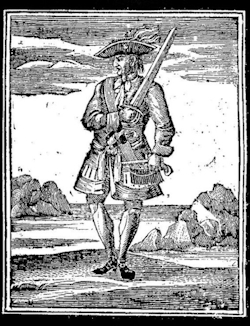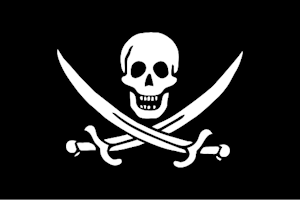
Rackham’s true first name was John, Jack being a nickname for John, said to have originated from the Middle English variation of John, which was commonly pronounced as ‘Jankin’ or ‘Jackin’, over time being shortened to ‘Jack’. His surname is usually spelt Rackham, although other spellings appeared in sources of in a time before spelling was standardized, such as Rackam, Rackum, Racum, or even Racan. The nickname ‘Calico Jack’ first appeared in the 1728 edition of Charles Johnson’s A General History of the Pyrates. It has been claimed he was born in Bristol, England, in 1682, but there is no surviving evidence of this. He is often considered as having been one of the least successful pirates of the Golden Age, only having captured fourteen vessels over a short period, seven of which were fishing boats, one a canoe, the others small trading vessels, obtaing no more than £1400 in plunder. His own vessel was a small 12-ton sloop armed with four guns and two swivels and his crew at time of capture consisted of only eighteen men and two women. He only seems to have become famous through his acquaintance with the two female pirates Ann Bonny and Mary Read with an intriguing back story mainly created by Captain Johnson in A General History. A lot of the details about him come from that book and most can’t be verified, some even being contradictory when comparing the 1724 and 1728 editions of the book. The most reliable details about his life generally only appear in his trial documents, government proclamations, and newspaper articles from 1720 onwards. He first appears in a proclamation for his arrest issued by Woodes Rogers in September 1720.
 There is a great deal of confusion concerning Rackham’s pirating career, the most quoted source being the 1724 and 1728 editions of A General History of the Pyrates. The trail of reliable evidence of Jack Rackham’s exploits as a pirate captain really begin on 22nd August 1720, when together with Ann Bonny and Mary Read he stole the William, a 4-gun sloop in Nassau, later attacking two vessels. His sailing master was George Fetherston, who had previously taken the King’s pardon and Richard Corner was his quartermaster. On 3rd September he robbed 7 fishing boats near Harbour Island, after which Woodes Rogers issues a warrant for his arrest on 5th September. Three sloops were sent out to hunt him down, so he left the Bahamas, but where he exactly went is unknown. It is generally thought he sailed to Cuba. He later appeared in Hispaniola, where he press-ganged a pair of French hunters. At the beginning of October he attacked two merchant sloops, seizing goods worth £1000, the biggest haul of his career. He turned up again on 19th October in Porto-Maria Bay, Jamaica, where he attacked a schooner called the Neptune, seizing tobacco and spice. The next day he attacked the sloop Mary. There are many other deeds attributed to him in the two editions of A General History, which vary greatly.
There is a great deal of confusion concerning Rackham’s pirating career, the most quoted source being the 1724 and 1728 editions of A General History of the Pyrates. The trail of reliable evidence of Jack Rackham’s exploits as a pirate captain really begin on 22nd August 1720, when together with Ann Bonny and Mary Read he stole the William, a 4-gun sloop in Nassau, later attacking two vessels. His sailing master was George Fetherston, who had previously taken the King’s pardon and Richard Corner was his quartermaster. On 3rd September he robbed 7 fishing boats near Harbour Island, after which Woodes Rogers issues a warrant for his arrest on 5th September. Three sloops were sent out to hunt him down, so he left the Bahamas, but where he exactly went is unknown. It is generally thought he sailed to Cuba. He later appeared in Hispaniola, where he press-ganged a pair of French hunters. At the beginning of October he attacked two merchant sloops, seizing goods worth £1000, the biggest haul of his career. He turned up again on 19th October in Porto-Maria Bay, Jamaica, where he attacked a schooner called the Neptune, seizing tobacco and spice. The next day he attacked the sloop Mary. There are many other deeds attributed to him in the two editions of A General History, which vary greatly.
Events recorded in the 1724 edition of A General History
 Jack Rackham was the quartermaster of Charles Vane. Vane was accused by Rackham and the crew of cowardice after refusing to attack a well-armed ship in the Windward Passage, and his crew deposed his as captain. Rackham was voted captain after the mutiny. Vane was banished with 15 supporters on a prize sloop in November 1718. It seems to be true that Vane was deposed as captain, but we don’t know for sure if Rackham was really the quartermaster of the Ranger as he wasn’t mentioned in Vane’s trial documents. After taking command, Rackham then sailed to the Caribbean where he captured four vessels. He was forced to abandon the prizes when pirate-hunters sent after him by Woodes Rogers caught up with him, escaping to Cuba. Rackham’s sloop was spotted by the Spanish coast guard, but Rackham deceived them by abandoning his own vessel and making off with one of their prize ships, but Johnson doesn’t say what happened to him after that. Some of Vane’s exploits are attributed to Rackham such as seizing a ship on which a Jamaican tavern keeper, Hosea Tisdell, was a passenger. Tisdell later testified that he was captured by Charles Vane. There is only a short mention of Rackham meeting Ann Bonny.
Jack Rackham was the quartermaster of Charles Vane. Vane was accused by Rackham and the crew of cowardice after refusing to attack a well-armed ship in the Windward Passage, and his crew deposed his as captain. Rackham was voted captain after the mutiny. Vane was banished with 15 supporters on a prize sloop in November 1718. It seems to be true that Vane was deposed as captain, but we don’t know for sure if Rackham was really the quartermaster of the Ranger as he wasn’t mentioned in Vane’s trial documents. After taking command, Rackham then sailed to the Caribbean where he captured four vessels. He was forced to abandon the prizes when pirate-hunters sent after him by Woodes Rogers caught up with him, escaping to Cuba. Rackham’s sloop was spotted by the Spanish coast guard, but Rackham deceived them by abandoning his own vessel and making off with one of their prize ships, but Johnson doesn’t say what happened to him after that. Some of Vane’s exploits are attributed to Rackham such as seizing a ship on which a Jamaican tavern keeper, Hosea Tisdell, was a passenger. Tisdell later testified that he was captured by Charles Vane. There is only a short mention of Rackham meeting Ann Bonny.
Events recorded in the 1728 edition of A General History
It is in this edition First that he is first called Calico Jack because of the clothes of calico he allegedly wore. This is the only source for this nickname. In this edition, Vane appoints Rackham as captain of a captured ship called the Kingston. After an heated argument over alcohol they part ways. Vane apparently never captured a ship called the Kingston, which was said to have been captured by a pirate called Thompson. Rackham sailed to the Isla de Pinos, where they buried their loot to make space for more plunder. Later they were attacked by pirate-hunters. Rackham and his men escaped in canoes and made it to New Providence, where they received the King’s pardon, but there are no records of this. It is claimed he met Ann Bonny in Nassau, who was already married to James Bonny. She couldn’t get a divorce so they escaped together in a stolen sloop. The story concerning the attempted divorce has never been verified. In this version they later meet Mary Read, when they captured the vessel she was sailing on, although it seems they met much earlier according to an official proclamation sent by Rogers to Boston newspapers.
Rackham’s flag
 Rackham is only known to have flown a white one, which is mentioned in The Tryals of John Rackham and other Pirates (1721). No flags are attributed to him in A General History. He probably didn’t have enough time to make one in his short stint as pirate captain, or it many not have been necessary to have one to scare the small vessels of his victims into submission. The iconic skull and crossed swords was first attributed to him in a German book by Hans Leip called the Bordbuch des Satans – Eine Chronik der Freibeuterei vom Altertum bis zur Gegenwart. (Logbook of Satan – A Chronicle of Piracy from Antiquity to Present) first published in 1959.
Rackham is only known to have flown a white one, which is mentioned in The Tryals of John Rackham and other Pirates (1721). No flags are attributed to him in A General History. He probably didn’t have enough time to make one in his short stint as pirate captain, or it many not have been necessary to have one to scare the small vessels of his victims into submission. The iconic skull and crossed swords was first attributed to him in a German book by Hans Leip called the Bordbuch des Satans – Eine Chronik der Freibeuterei vom Altertum bis zur Gegenwart. (Logbook of Satan – A Chronicle of Piracy from Antiquity to Present) first published in 1959.
Rackham’s fate
“If he had fought like a Man, he need not have been hang’d like a Dog.” – reported to have been said by Ann Bonny about Rackham in A General History of the Pyrates (1724)
In October 1720, Rackham’s vessel was anchored off Negril Point to the west of Jamaica, where they had just picked up some recruits, who at their trial claimed to be turtle fishermen lured aboard Rackham’s vessel under false pretences. It was at this time Rackham is reported to have been flying a white flag, the only description of a flag flown by him. There he was observed by an unknown sloop commanded by Captain Bonnevie, who raised the alarm, returning with another sloop under Jonathan Barnet on 22nd October 1720. The pirates were drunk when the pirate-hunters arrived, attempting to escape by using the vessel’s sweeps. In the evening, Barnet, also using his sweeps, caught up with Rackham’s vessel and enquired where they were from while ordering them to surrender. Rackham, or one of his men, fired a swivel gun in reply. Barnet returned fire, severing the boom of Rackham’s sloop. According to one of the forced Frenchmen, the crew then hid below deck. It is claimed that Bonny and Read were the only ones to put up a fight, but there is no evidence of that. The pirates promptly surrendered and were taken to St. Jago de la Vega, also known as Spanish Town, in Jamaica. At their trial, which was presided over by Sir Nicholas Lawes, Governor of Jamaica, all the pirates pleaded not guilty, denying that they had ever carried out any acts of piracy. Rackham and eight associates were found guilty and hanged on 18th November 1720 after a career of as short as two months as a pirate captain, depending on which version of his life one believes. It is said that his head was placed on a pole and his headless corpse placed in a gibbet on a small cay as a warning to others.
For more information on Jack Rackham watch the informative video below by Gold and Gunpowder.
